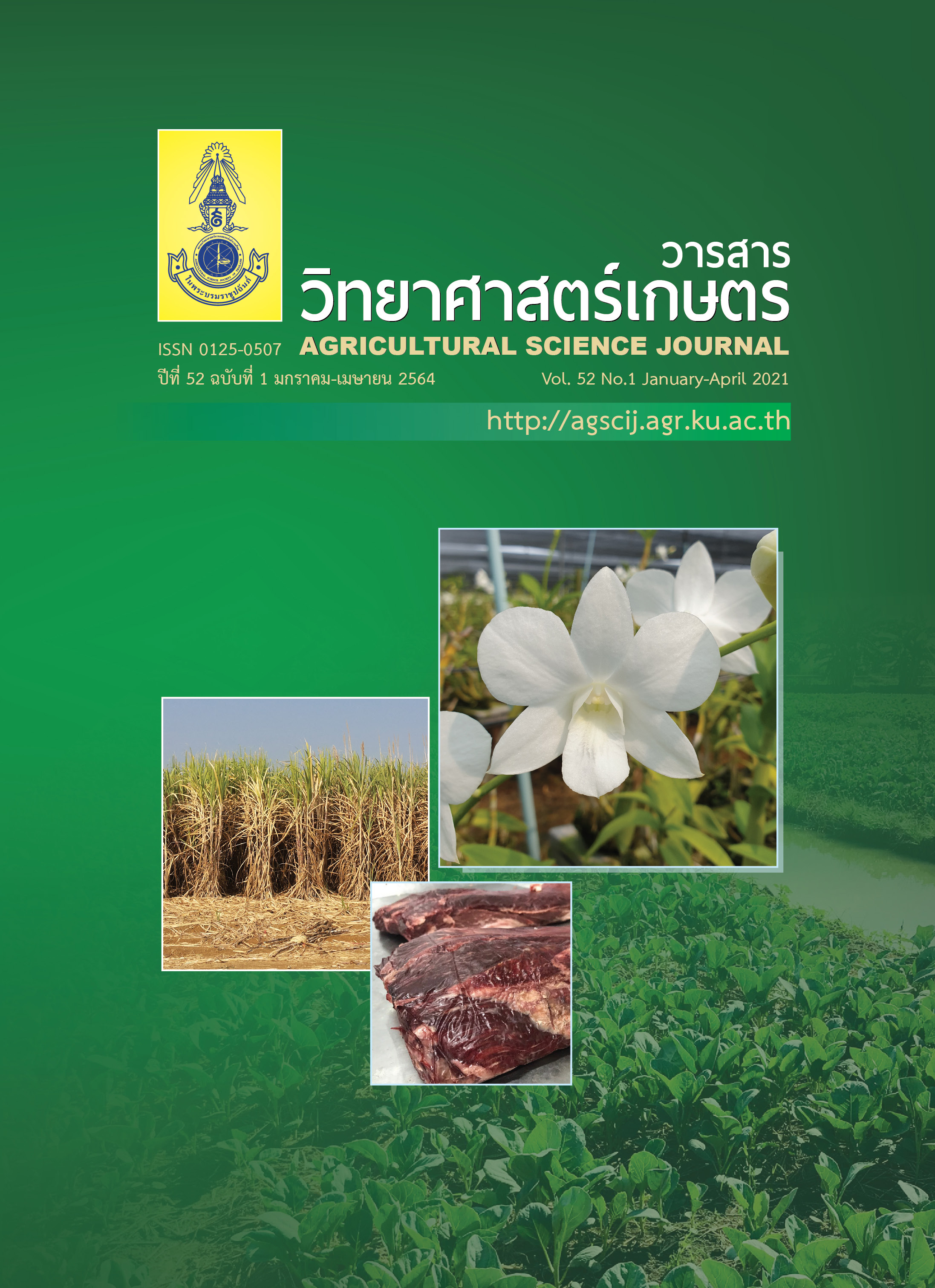การเปรียบเทียบรูปแบบและวิธีการลดอุณหภูมิภายในโรงเรือนต่อการเจริญเติบโตและคุณภาพดอกของกล้วยไม้สกุลหวายพันธุ์ขาวฟอร์ม
Main Article Content
บทคัดย่อ
การผลิตกล้วยไม้ตัดดอกสกุลหวายภายใต้โรงเรือนตาข่ายพรางแสงนั้น ไม่สามารถควบคุมสภาพแวดล้อมให้เหมาะสมต่อการเจริญเติบโตได้ตลอดทั้งปี ดังนั้น การพัฒนาโรงเรือนที่ช่วยลดความแปรปรวนของสภาพอากาศเป็นแนวทางหนึ่งเพื่อแก้ไขปัญหาดังกล่าว การศึกษานี้มีวัตถุประสงค์เพื่อเปรียบเทียบการเจริญเติบโตและคุณภาพดอกของกล้วยไม้สกุลหวายพันธุ์ขาวฟอร์มในโรงเรือนลดความร้อนแตกต่างกัน วางแผนการทดลองแบบสุ่มสมบูรณ์ ประกอบด้วย 4 ทรีตเมนต์ ได้แก่ โรงเรือนตาข่ายพรางแสง (ชุดควบคุม: G1) และโรงเรือนลดความร้อนอีก 3 แบบ สร้างภายใต้หลังคาตาข่ายพรางแสง เป็นโรงเรือนกึ่งเปิดรูปทรงกอไก่ ขนาด 6×24×3 เมตร ด้านข้างคลุมด้วยมุ้งตาข่ายไนล่อนสีขาว มีระบบควบคุมอุณหภูมิต่างกัน คือ อาศัยลมธรรมชาติ (G2) พัดลมไอน้ำ (G3) และพัดลมระบายอากาศ (G4) ติดตามสภาพแวดล้อมตลอดช่วงเวลาที่ศึกษา (เดือนตุลาคม พ.ศ. 2561 ถึงเดือนพฤศจิกายน พ.ศ. 2562) ผลการศึกษา พบว่า โรงเรือนทั้ง 4 แบบ มีอุณหภูมิและความชื้นสัมพัทธ์ใกล้เคียงกัน แต่โรงเรือน G1 มีความเข้มแสงสูงกว่าโรงเรือนอื่น ๆ 1–2 เท่า (P < 0.05) สำหรับการเจริญเติบโตเมื่อสุดลำ พบว่า ลำที่ 1 (3 เดือนหลังปลูก) มีความสูงลำมากที่สุด (18.42 เซนติเมตร) เมื่อปลูกในโรงเรือน G2 ส่วนลำที่ 2 (8 เดือนหลังปลูก) มีความสูงลำ 28.0–31.1 เซนติเมตร ซึ่งไม่แตกต่างกันในแต่ละโรงเรือน ขณะที่ ลำที่ 3 (13 เดือนหลังปลูก) มีความสูงลำสูงที่สุด (34.78 เซนติเมตร) เมื่อปลูกในโรงเรือน G1 การประเมินจำนวนและคุณภาพช่อดอกจากลำที่ 2 พบว่า จำนวนและความยาวช่อดอก จำนวนดอกต่อช่อ และขนาดดอกของต้นที่ปลูกในโรงเรือน G1 มีแนวโน้มมากที่สุด แต่มีอายุการปักแจกันไม่แตกต่างกัน (16 วัน) ทั้งนี้ โรงเรือนหลังคาพลาสติกที่คลุมด้วยมุ้งไนล่อน (G2 G3 และ G4) ทำให้กล้วยไม้ทั้ง 3 ลำ มีขนาดใบ ความเขียวใบ และปริมาณคลอโรฟิลล์สูงกว่าโรงเรือน G1
Article Details
เอกสารอ้างอิง
Ausahawong, K., P. Boonkorkaew, P. Kasemsap and A. Mongkolchaiyaphruek. 2018. Growth and photosynthetic parameters of Dendrobium orchids cultivated under different greenhouse conditions. Agricultural Sci. J. 49(Suppl. 2): 573–576. (in Thai)
Boonchai, D., P. Boonkorkaew and P. Kasemsap. 2017. The correlation between CO2 uptake of CAM Dendrobium hybrid and environmental factors under shade net house conditions. Thai J. Agric. Sci. 50(1): 26–35.
Boonkorkaew, P., D. Boonchai, A. Mongkolchaiyaphruek, U. Lertsuchatavanich, B. Sangtongpraow, A. Sirijinda, J. Sathornkich and O. Piasai. 2016. Evaluation of Dendrobium Orchid Production Potential under Environmental Control Semi–Open Greenhouse. Research Report. Kasetsart University, Bangkok. 86 pp. (in Thai)
Fankhauser, C. and J. Chory. 1997. Light control of plant development. Annu. Rev. Cell. Dev. Biol. 13(1): 203–229.
Kahohem, N., P. Boonkorkaew and K. Thanomchit. 2018. Effect of concrete block as growing media on growth of two Dendrobium orchid cultivars. Agricultural Sci. J. 49(Suppl. 2): 409–412. (in Thai)
Kasemsap, P. 2020. Biology 2: Textbook of Science and Mathematics for the Promotion of Academic Olympiad and Development of Science Education Foundation under the Patronage of Her Royal Highness Princess Galyani Vadhana Krom Luang Naradhiwas Rajanagarindra. 7th edition. Darnsutha Press Co., Ltd., Bangkok. (in Thai)
Kim, S.J., D.J. Yu, T.C. Kim and H.J. Lee. 2011. Growth and photosynthetic characteristics of blueberry (Vaccinium corymbosum cv. Bluecrop) under various shade levels. Sci. Hortic. 129(3): 486–492.
Kitipatthaworn, S. 2011. Vegetative Growth of Cut Dendrobium Hybrid and the Correlation with Annual Climatic Variation. MS Thesis, Kasetsart University, Bangkok. (in Thai)
Kitipatthaworn, S. and P. Saradhuldhat. 2010. Effects of climatic factors on vegetative growth and development of Dendrobium ‘Ear Sakul’, pp. 1673–1680. In Proc. the 7th Kasetsart University Kamphaeng Saen Campus Conference, 7–8 December 2010. (in Thai)
Klavsen, S.K. and S.C. Maberly. 2010. Effect of light and CO2 on inorganic carbon uptake in the invasive aquatic CAM–plant Crassula helmsii. Funct. Plant Biol. 37(8): 737–747.
Kumar, R., S. Sharma and V. Pathania. 2013. Effect of shading and plant density on growth, yield and oil composition of clary sage (Salvia sclarea L.) in north western Himalaya. J. Essent. Oil Res. 25(1): 23–32.
Lee, H.B., J.H. Lee, S.K. An, J.H. Park and K.S. Kim. 2019. Growth characteristics and flowering initiation of Phalaenopsis Queen Beer ‘Mantefon’ as affected by the daily light integral. Hortic. Environ. Biotechnol. 60(5): 637–645.
Porra, R.J., W.A. Thompson and P.E. Kriedemann. 1989. Determination of accurate extinction coefficients and simultaneous equations for assaying chlorophylls a and b extracted with four different solvents: verification of the concentration of chlorophyll standards by atomic absorption spectroscopy. Biochim. Biophys. Acta. 975(3): 384–394.
Smith, H. 1982. Light quality, photoperception, and plant strategy. Ann. Rev. Plant Physiol. 33: 481–518.
Suwanwong, S. 2020. Plant Response under Unfavorable Environment. Wanida Karnpim Part., Ltd., Nonthaburi. (in Thai)
Tiampayotorn, J. and S. Meyanyieam. 2010. The cut–flower orchid production in industrial system, pp. 139–146. In Thai Orchid Database. Biodiversity–Based Economy Development Office (Public Organization), Bangkok. (in Thai)


